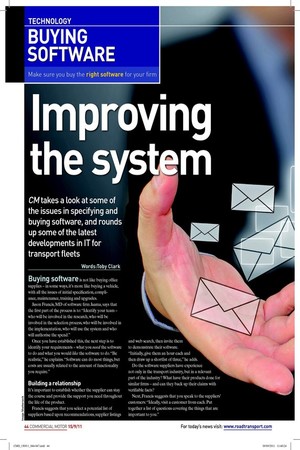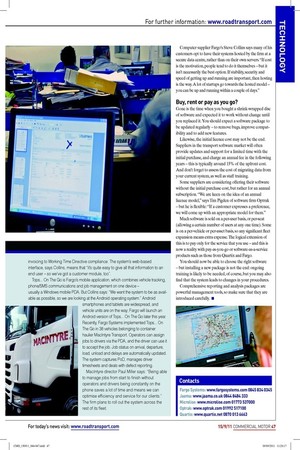Improving
Page 38

Page 40

Page 41

If you've noticed an error in this article please click here to report it so we can fix it.
the system
CM takes a look at some of the issues in specifying and buying software, and rounds up some of the latest developments in IT for transport fleets Words:Toby Clark Buying software is not like buying ofice
supplies – in some ways, it’s more like buying a vehicle, with all the issues of initial speciication, compliance, maintenance, training and upgrades.
Jason Francis, MD of software irm Jaama, says that the irst part of the process is to: “Identify your team – who will be involved in the research, who will be involved in the selection process, who will be involved in the implementation, who will use the system and who will authorise the spend.” Once you have established this, the next step is to identify your requirements – what you need the software to do and what you would like the software to do. “Be realistic,” he explains. “Software can do most things, but costs are usually related to the amount of functionality you require.”
Building a relationship
It’s important to establish whether the supplier can stay the course and provide the support you need throughout the life of the product.
Francis suggests that you select a potential list of suppliers based upon recommendations, supplier listings and web search, then invite them to demonstrate their software.
“Initially, give them an hour each and then draw up a shortlist of three,” he adds.
Do the software suppliers have experience not only in the transport industry, but in a relevant part of the industry? What have their products done for similar irms – and can they back up their claims with veriiable facts?
Next, Francis suggests that you speak to the suppliers’ customers: “Ideally, visit a customer from each. Put together a list of questions covering the things that are important to you.” Questions might include the following: • What problems did you encounter during implementation?
• Did you receive adequate training?
• What documentation have you been given?
• Do you need to use the support service?
• What has been the impact on cost and service levels?
• Have you seen a return on your investment?
Invite the inal shortlist of suppliers back for a more detailed demonstration, and make sure you involve the people who will actually use the software. Remember that bigger is not necessarily better: a product with a long ‘laundry list’ of features may not work as well for you as a more focused, apparently more limited product.
Keep it compatible
One of the irst questions is whether the new system needs to ‘talk to’ your existing systems. Direct compatibility with previous systems is nice to have, but not necessarily the best way to go, as it may limit your choices to a particular supplier. It’s worth seeing if existing data can be translated to a new system by the new supplier – this is often a relatively straightforward process. Nevertheless, systems that use open or widely used standards are likely to be more easily updated or integrated with other systems later.
Similarly, compatibility with existing hardware systems can be overrated: the price/performance ratio of PCs is improving fast. It is often cheaper to replace hardware than to upgrade it. Computer supplier Fargo’s Steve Collins says many of his customers opt to have their systems hosted by the irm at a secure data centre, rather than on their own servers. “If cost is the motivation, people tend to do it themselves – but it isn’t necessarily the best option. If stability, security and speed of getting up and running are important, then hosting is the way. A lot of startups go towards the hosted model – you can be up and running within a couple of days.”
Buy, rent or pay as you go?
Gone is the time when you bought a shrink-wrapped disc of software and expected it to work without change until you replaced it. You should expect a software package to be updated regularly – to remove bugs, improve compatibility and to add new features.
Likewise, the initial licence cost may not be the end. Suppliers in the transport software market will often provide updates and support for a limited time with the initial purchase, and charge an annual fee in the following years – this is typically around 15% of the upfront cost. And don’t forget to assess the cost of migrating data from your current system, as well as staff training.
Some suppliers are considering offering their software without the initial purchase cost, but rather for an annual subscription. “We are keen on the idea of an annual licence model,” says Tim Pigden of software irm Optrak – but he is lexible: “If a customer expresses a preference, we will come up with an appropriate model for them.” Much software is sold on a per-user basis, or per-seat (allowing a certain number of users at any one time). Some is on a per-vehicle or per-asset basis, so any signiicant leet expansion means extra expense. The logical extension of this is to pay only for the service that you use – and this is now a reality with pay-as-you-go or software-as-a-service products such as those from Quartix and Fargo.
You should now be able to choose the right software – but installing a new package is not the end: ongoing training is likely to be needed, of course, but you may also ind that the system leads to changes in your procedures.
Comprehensive reporting and analysis packages are powerful management tools, so make sure that they are introduced carefully. ■













































